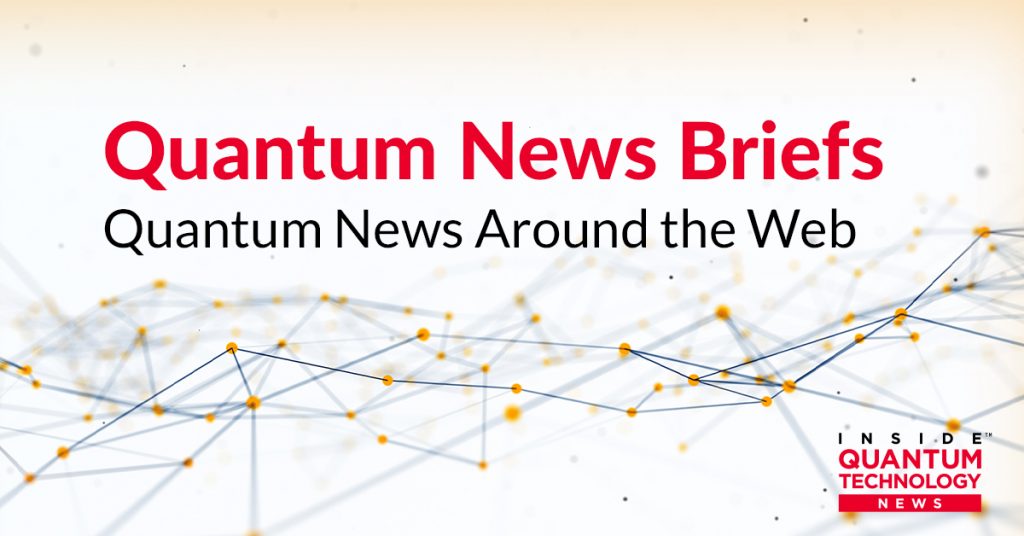Quantum New Briefs opens today with the announcement from Cybersecurity and Infrastructure Security Agency (CISA) announcement about the establishment of its Post-Quantum Cryptography Initiative followed by groundbreaking news from Germany relating the successful quantum entanglement of two atoms separated by 33 km (20.5 miles) of fiber optics. Quantum-related satellites in today’s lineup from South Korea where LG Plus is using D-Wave computers for satellite communication and QuantLR and Lightpath Techologies partnership to develop free-space quantum encryption system.
*****
CISA Announces Post-Quantum Cryptography Initiative
Although NIST does not expect to publish a standard for use by commercial products until 2024, organizations should start preparing for the transition now by following the DHS and NIST Post-Quantum Cryptography Roadmap. As this technology advances over the next decade, quantum computing is increasing risk to some encryption methods that are widely used to protect customer data, complete business transactions, and secure communications. This roadmap identifies where organizations need to develop plans for the transition to post-quantum cryptography. For more information about DHS efforts, visit DHS.gov/quantum.
*****
Record-Setting Quantum Entanglement Connects Two Atoms Across 20 Miles
In the new study, researchers from Ludwig-Maximilians-University Munich (LMU) and Saarland University have now broken a distance record for quantum entanglement between two atoms over fiber optics.
In their experiments, the team entangled two rubidium atoms kept in optical traps in two different buildings on the LMU campus. They were separated by 700 m (2,297 ft) of fiber optics, which was extended out to 33 km with extra spools of cable. Each atom was excited with a laser pulse, which causes it to emit a photon that’s quantum entangled with the atom.
The team says this is an important step on the way to realizing a practical quantum internet. This study shows that they can operate using existing fiber optic infrastructure. This could be paired with technologies like satellites, which have previously demonstrated the ability to beam entangled photons over thousands of kilometers. Click here for more details from Michael Irving in New Atlas.
LG Uplus Uses D-Wave Quantum Computer for Optimized 6G Satellite Communication
LG Uplus (LGU+) said that researchers have used a quantum computer commercialized by D-Wave Systems, a Canadian quantum computing company, to quickly calculate the number and distance of surrounding satellites that can communicate from one satellite.
In their joint research for six months that began in December 2021, researchers from LGU+ and the Korea Advanced Institute of Science and Technology (KAIST) found that services that are not different from ground communication can be implemented even in satellite communication environments through network optimization algorithms.
*****
QuantLR & LightPath Technologies Announce Partnership to Develop Free-Space Quantum Encryption System
LightPath and QuantLR will join forces to develop a ground-to-satellite, ground-to-air, ground-to-ground, and satellite-to-satellite free space optical communication channels, which will be used for a generation of quantum encryption keys, enabling secure quantum communication (QKD). It is intended that this project can then be further developed for use in high-rate data transmission, optical communication both between satellite and ground station, as well as satellite-to-satellite communications.
*****
AWS Buys Before It Tries with Quantum Networking Center
In 2020, the US Department of Energy created a Quantum Internet Blueprint with four priority quantum network research areas that make clear how preliminary current concepts are:
**Determine what hardware will be needed to create a scalable quantum internet;
**Determine how to integrate multiple quantum networking devices;
**Determine how to repeat, route, and switch quantum signals;
**Determine how to handle errors in quantum networks;
With all the engineering and scientific challenges in the way, AWS’s Center for Quantum Networking has a lot of problems to choose from – but didn’t specify any in its announcement. Read Vigliarolo’s complete article in TheARegister here.
*****
Sandra K. Helsel, Ph.D. has been researching and reporting on frontier technologies since 1990. She has her Ph.D. from the University of Arizona.
